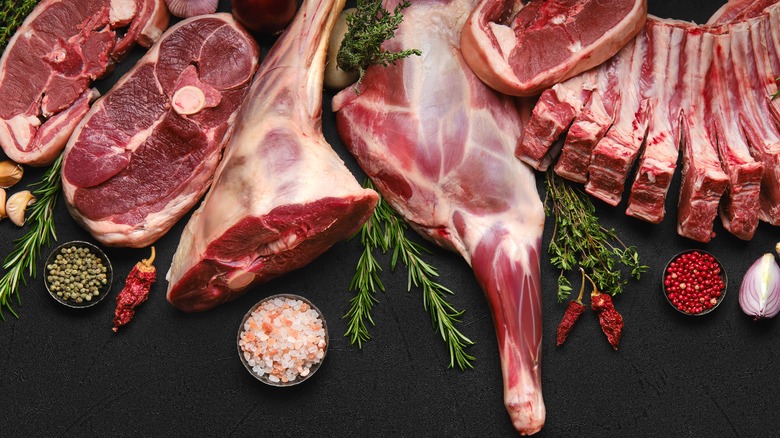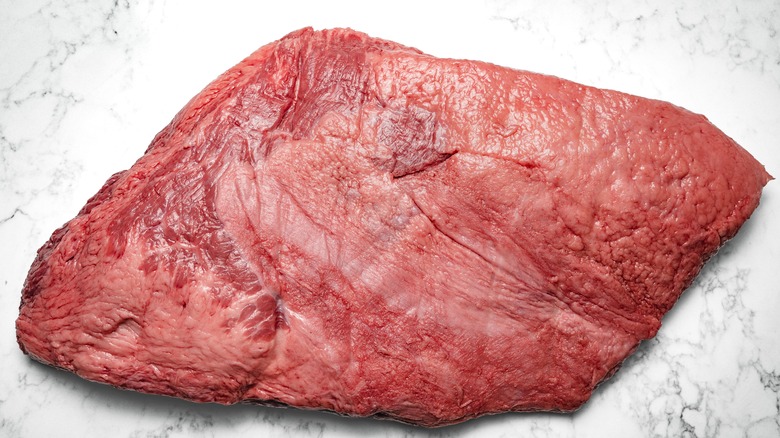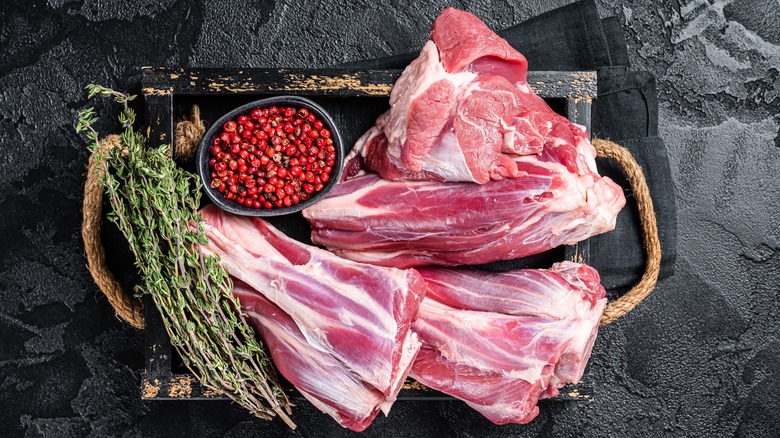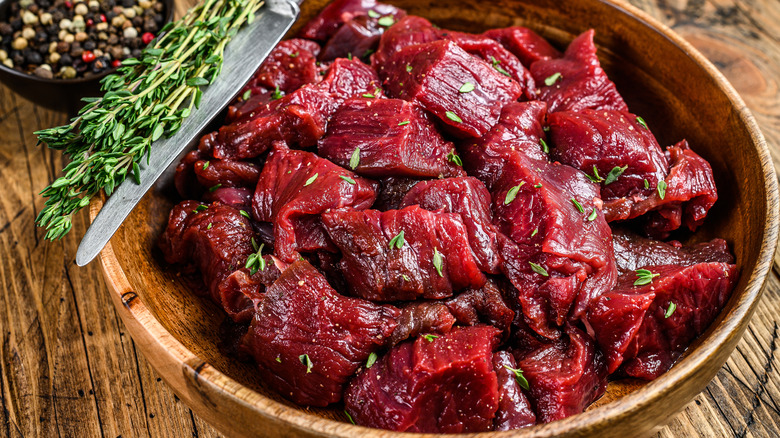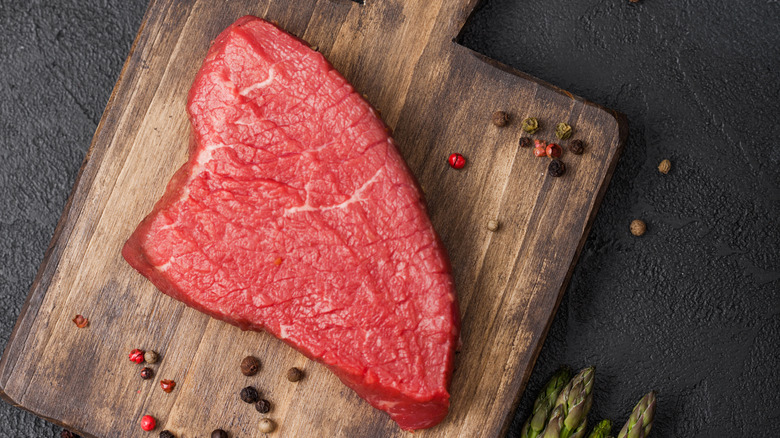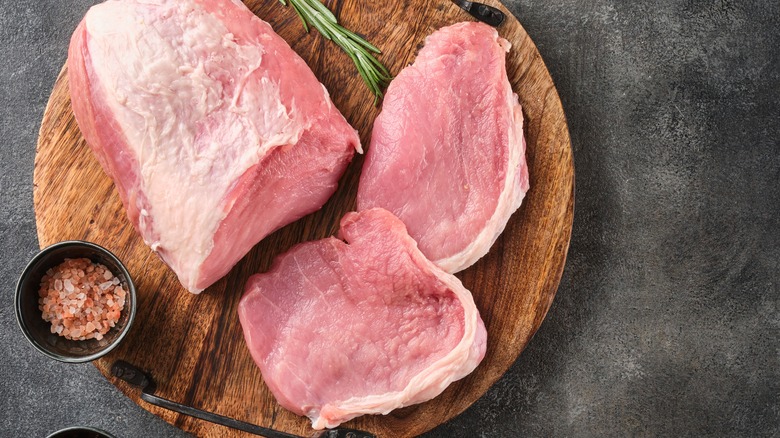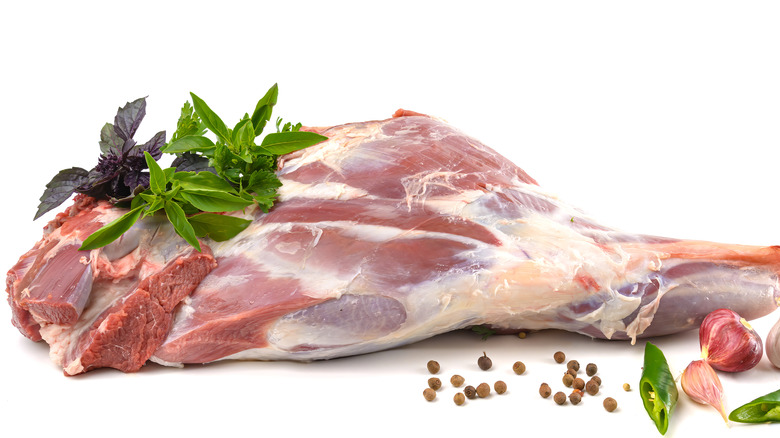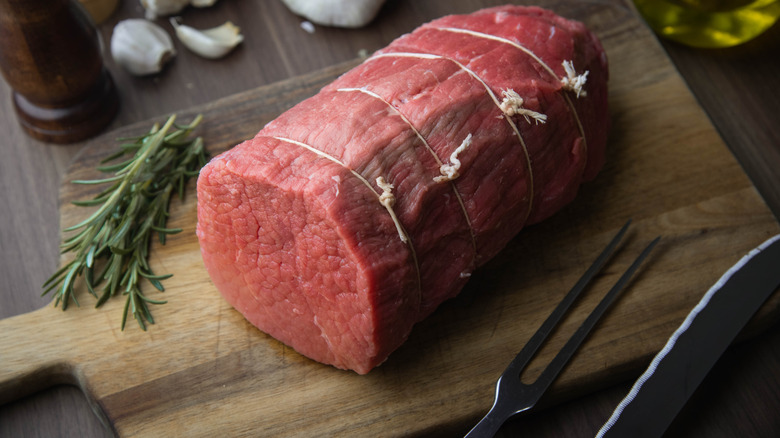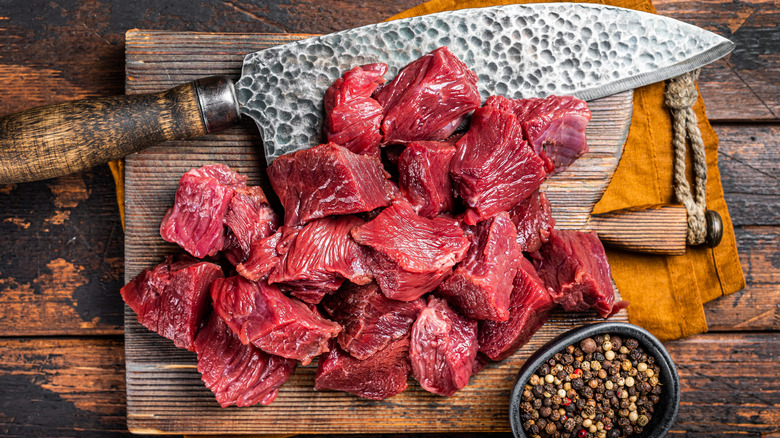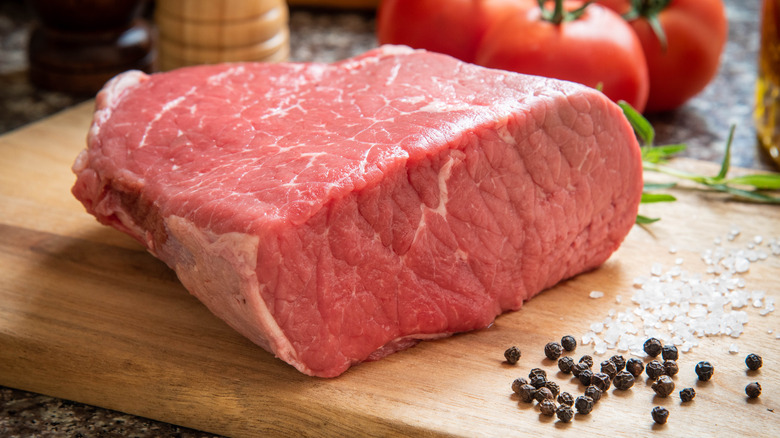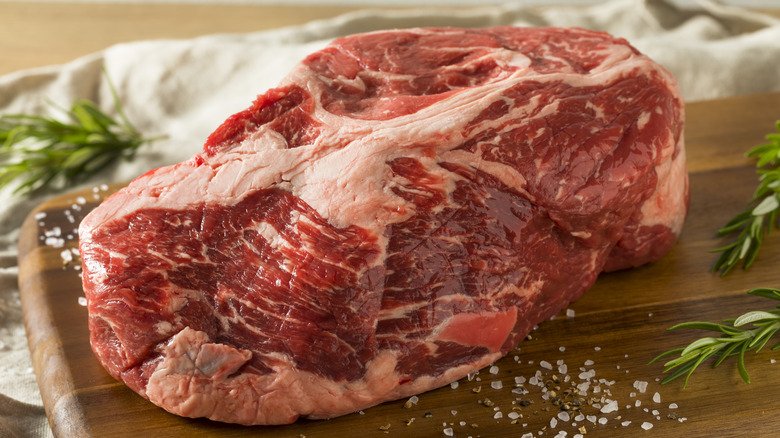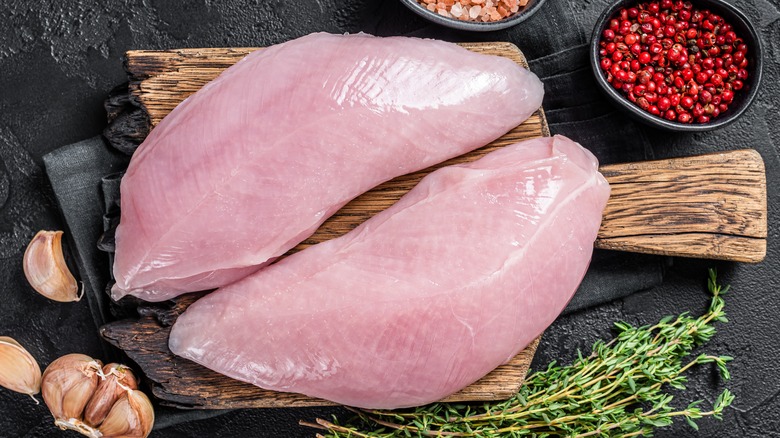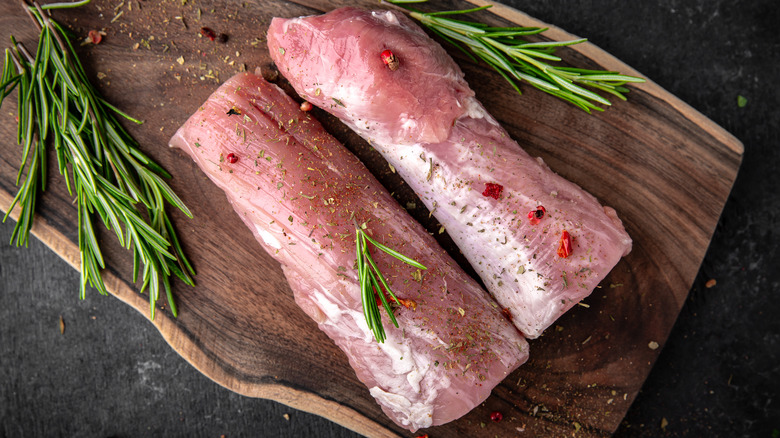12 Best Cuts Of Meat For Pressure Canning
Though canning food isn't a new concept, the pressure canning method came roughly 170 years ago to safely can low-acid foods (like meat) at a higher temperature to kill off dangerous bacteria effectively. Pressure canning meat is done via two methods: hot pack — browning the meat before canning, and raw pack — cold, raw meat canned with no liquid. A hot pack is preferred for getting the most out of your canned meat, and salting is optional based on preference.
The best meat for canning includes cuts from the area of the animal that does most of the moving, such as the leg, shoulder, chest, and rump. These are tougher cuts and naturally leaner. They're often on sale or sold at a lower price and are available in large quantities because of the cut. Look for cuts that have very little marbling (if you're not sure, here's how to tell the difference between tough and tender meat), and be sure to trim any fat before canning. Read on to discover some of the best cuts of meat for pressure canning.
1. Flat-cut Beef Brisket
Beef is king, and who doesn't love brisket? Brisket is one of the best cuts of meat for pressure canning because it packs robust flavor, is lean, and relatively cheap. The brisket comes from the hardworking chest muscles and is separated into the point and flat. Usually, the first cut from the leaner part of the whole brisket, the flat-cut is tougher, and the point is fattier. You'll often find the entire brisket being sold at a butcher and the separated cuts at your local grocer. With everything you need to know about brisket, learn how to source quality brisket if you'll preserve it.
Flat-cut beef brisket is a leading option for canning due to the high amounts of connective tissue that run throughout the muscle. Best suited for slow cooking, roasting, and smoking, canned brisket benefits from the time it takes to break down the collagen to create a more tender chew. The full-bodied beef savor only enhances as it sits. Canning flat-cut beef brisket quickly adds depth and oomph to hearty stews, rich chilis, and saucy one-pot dishes. This cut is available in weight from 5 to 10 pounds, so it's a smart choice when you're preparing multiple jars to be canned.
2. Lamb Shank
Lamb shank is often an overlooked cut of meat. Don't be scared off due to its strong and intense bite; this boldness is really what sets it apart from the more popular leg of lamb. Shank is cut from the lower back portion of the leg, just above the knee, which is a hard-working muscle full of collagen. This well-woven connective tissue makes the meat tough until it has time to break down and soften. Leg of lamb is the upper cut of the leg, naturally more tender, and the wild punch is not as obvious. Both cuts require slow cooking, roasting or braising being the most common methods.
Canning the shank is preferred because it has a tougher nature than leg of lamb but also features that tangy creaminess lamb is known for. Storing the tougher meat makes it more tender as it sits and creates deeper flavor for easy-to-make stews or other slow-cooked meals. It's also less expensive than other cuts of lamb, so your pantry can be stocked with a decadent meat at a cheaper cost, ready to go for a comforting stew or spicy curry.
3. Venison Shoulder
For many individuals, deer is what comes to mind when they hear the term venison, but venison means more than just deer; it includes meat from elk and moose as well. Considered very lean with an intense wild flavor, venison shoulder is a prime candidate for pressure canning (and also dehydrating for jerky). Not only does the process help tenderize the sinewy meat, but if you've come by venison in large quantities, canning helps preserve your surplus bounty.
But why the shoulder? The shoulder is a working muscle on deer, elk, and moose, and one that gets a workout, making it more fibrous and difficult to chew. It's often used for ground meat, benefits from slow cooking, and goes best with dense dishes that feature bold ingredients like chilis and stews. But if you're going to can ground venison shoulder, the NCHFP (National Center for Home Food Preservation) recommends adding 1 part of lard or tallow to 3 parts of venison when grinding it.
Lightly cook or brown the ground shoulder, drain or remove the rendered fat, and can your venison as usual. Alternatively, shape your ground mixture into meatballs or sausages and brown those as well before canning.
4. Beef Sirloin Tip
Beef sirloin tip naturally makes the list of best cuts of meat for pressure canning due to its lean but still very tasty nature. This versatile cut is from the rump and hind legs, or the round, and is frequently made into ground burger. But it's also available as roasts, steaks, and chunks, and does well roasted, grilled, braised, or stewed. Typically inexpensive, beef sirloin tip has virtually no fat to trim, which makes it quick and easy to prepare for canning. And that's convenient because the sirloin benefits from canning; it becomes more tender while developing and blossoming in its innate umami.
Having a jar of ready-to-go sirloin tip chunks safely stored in your pantry gives you a tender, satiating, and savory ingredient to add to casseroles or one-pot dishes quickly. You can also liven up soups, beef up leftovers, enhance sauces, or add more flavor to beef stew. Beef sirloin tip can also be preserved as ground burger — just be sure to brown the meat and drain the fat before adding the ground sirloin to your jars for canning.
5. Pork Loin
Not to be confused with pork tenderloin, the pork loin is a thicker, wider cut and comes from the back of the pig near the rump. Still a lean cut of meat, the pork loin holds more flavor than the tenderloin because, unlike the tenderloin, the pork loin sometimes features a fat cap — an edge of fat along the piece of meat. Though this may need to be trimmed for canning, it's easy to cut off and save for later use, such as rendering the fat to create lard and cracklings. So not only do you add to your collection of preserved meats, but you also get to munch on fried, crispy, juicy, salty pork bits while you're doing it.
Typically available boneless and often slow-cooked via roasting, pork loin is a complementary protein to many other foods, making it a flexible option to have on hand in your pantry. Though you won't can the roast whole, cubed pork loin can be a welcome addition to soups, chowders, egg scrambles, and one-pan meals of varying cuisines. Affordable, versatile, and easy to work with, pork loin serves as one of the best cuts of meat for pressure canning.
6. Mutton Leg
Mutton leg is a solid choice for pressure canning. Not typically seen in American cuisine, mutton is often found in Middle Eastern and Indian dishes, such as curries and biryanis. The same animal as lamb, mutton is a sheep older than 1 year, while a lamb is younger than 1 year. Mutton embodies a full and dense bite that is reminiscent of venison with its strong, potent, wild flavor. It's a tougher meat than its younger and more tender counterpart, but much like lamb shank, mutton leg is full of connective tissue and requires slow cooking to soften the fibers.
Mutton leg is available boneless or bone-in, less expensive than lamb, and a popular choice for the smoker. But given that mutton leg is a fairly sinewy cut, pressure canning is an effective way to keep the meat from becoming dry and chewy when you add it to your favorite curry or stew dish at a later date. Canned mutton is enhanced with nutty, peppery, or earthy spices and does well in recipes that feature bold, rich ingredients.
7. Beef Eye of Round
For a milder taste of beef, consider canning the beef eye of round. This cut is often made into deli roast beef or ground into burgers. Often affordable due to being a tough cut, the round comes from the rump, and the eye is cut from a muscle in the center of the rump. The eye of round is found as singular steaks, whole roasts, or as a tenderloin. Since the eye of round is lean, it doesn't have much fat to trim and is easy to cube into chunks. But the eye of round is definitely one type of steak you should be tenderizing, which makes it a valued option for pressure canning.
The beef eye of round is a cut that benefits from roasting, braising, and other slow-cooking methods, so understandably, it's a cut of meat that also benefits from canning. Chosen because of its lack of fat, the eye of round is favorable to a number of flavor profiles due to its lighter beef taste. Some compatible seasonings include rosemary, black pepper, mustard, garlic, and salt.
8. Venison Bottom Round
Venison bottom round is another great cut of meat for pressure canning because it's a working muscle that features lean meat and very little fat. Whether from deer, elk, or moose, the hardworking hindquarter yields quite a bit of meat, and canning is an effective preservation method for storing any extra you may get from the large cuts. The bottom round comes from the leg portion of the hindquarters and is typically sold boneless. It's usually slow-roasted or made into cutlets.
The bottom round of venison is a popular choice for making sausages since the meat is dense and requires some fat to balance it out. Mix 1 part pork or beef fat with 3 to 4 parts of venison meat to get just the right balance when canning sausages. Add bold, sharp seasonings to harmonize with the potent venison meat, from earthy herbs like oregano or marjoram to spicy hots such as cayenne or chipotle. If you choose to preserve the bottom round as ground meat, you must use the hot pack method and sear the sausages before canning.
9. Beef Bottom Round
Beef bottom round is cut from the bottom round flat and is either referred to as an outside round or, if it's cut from the tip of the rump end, as a rump roast. This cut is inexpensive because the bottom round hails from the working muscles of the hindquarters, creating lean, tough meat. Frequently cut to be cooked as a pot roast, whether slow-roasted in the oven or stewed in the slow cooker, bottom round benefits from additional liquids and fats and a lengthy cooking time. But when the connective tissue has a chance to break down, the resulting slow-cooked meat falls apart with just a fork.
Even though beef bottom round is typically sold as a roast, this cut still benefits from the canning process. As versatile as it is, canned beef chunks can be added to stews, soups, casseroles, and other one-pot meals for a robust dinner any night of the week. Beef bottom round is certainly one canned meat you should consider stocking in your pantry.
10. Beef Chuck
The almighty beef chuck is a controversial cut of meat that either receives the love it deserves or gets cast aside with nothing more than a sneer. Yet chuck is the go-to beef cut for households everywhere, with chuck being the most popular choice for ground burgers. Yielding a bit more fat than most other primal cuts good for canning, chuck is well-marbled with connective tissue, so slow cooking is best. Compatible with what seems like an endless list of ingredients, beef chuck is also sold as steaks, roasts, and chunks.
Beef chuck is cut from the shoulder and considered a working muscle. And though cows can and do jump from time to time, their shoulders aren't nearly as lean as the harder-working shoulder of venison. Most commonly reached for when pot roast is on the menu, chuck may require a little bit of trimming before canning. But since it's a cut with a range of culinary potential, prepping your roast for storage is worth the delicious and comforting dishes you can create later with your canned beef chuck.
11. Turkey Breast
Turkey breast (skinless) makes the list because it's lean and mild yet tender and distinct. Though the entire bird can be prepped for canning, like most poultry, turkey breast is a convenient cut to grab at the store for an easy way to preserve some white meat. It's also an economical choice that won't break your budget. Turkey breast is a versatile companion to a number of comforting recipes, including one pot turkey tetrazzini — a dish that also features mushrooms, peas, and diced onion in a Parmesan cream sauce, which is typically served over spaghetti or noodles.
But the process is a little different when it comes to canning poultry. Though it's recommended to brown meat before canning to get the best quality out of your preservation, browning poultry over high heat could leave it pretty dry. Even a raw pack can leave the turkey dry. For best results, cook your turkey until it's about two-thirds of the way done before canning — boil, simmer, or bake. Your turkey won't dry out; you'll have a ready-to-go option for leftovers turkey pot pie. But instead of going through the hassle of roasting an entire turkey to obtain leftovers, you'll have a fresh, tender turkey just waiting to be eaten.
12. Pork Tenderloin
One of the reasons why the pork tenderloin is ranked the worst cut of pork is one of the reasons why it's one of the best cuts of meat for pressure canning. Pork tenderloin is, yep, tender but also very lean and, therefore, not typically a favorite among the pork-eating crowd. The tenderloin benefits from pressure cooking because the extremely mild flavor has time to manifest a bit. About as lean and light as chicken, pork tenderloin might just be interchangeable with chicken in some recipes.
Though different than pork loin, pork tenderloin also comes from the loin but is boneless and cut from along the spine, which results in a much thinner and longer piece of meat. Pork tenderloin is usually slow-roasted, but cubed pork tenderloin goes well with a wide selection of ingredients and seasonings. Use your canned pork tenderloin to whip up a pork and vegetable casserole or frittata for a weeknight meal, or toss tenderloin chunks in with some tomato sauce as it simmers for Sunday dinner.
